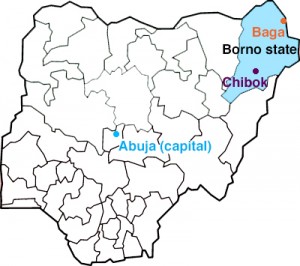In the wake of last week’s massacre in the Baga area, a small cluster of towns near Lake Chad in northeastern Nigeria, Nigerian writer Emmanuel Iduma published a short essay on “the tyranny of mass deaths, and mass burials.” In Nigeria, Iduma wrote, “joy … is an unclaimed territory.” Across Nigeria’s northeast Borno state, where Boko Haram and Nigerian military forces battle with sometimes-equal violence, joy’s unclaimed territory grows larger by the day.
Like the mass kidnapping last April of schoolgirls in Chibok, which led to the short-lived international #BringBackOurGirls viral campaign, Boko Haram’s January 7 attack on Baga has cast the group’s atrocities in their fullest light. The terrorist group’s fighters killed hundreds of civilians between January 3 (the group’s initial assault on a multinational military base in the area) and the January 7 attack. Since that first assault, thousands have fled the area to a dwindling supply of safe havens in Borno; others have turned to Chad, across the lake, where many of the refugees have drowned, according to local officials.

Reports of mass killing in Baga have followed a pattern unfortunately familiar to observers of violent conflict in Nigeria. First, the BBC noted a tentative death toll of 2,000, one-fifth of Baga’s total population. Multiple publications followed with alternative tolls of “hundreds”—lower in number, but no lesser in tragedy. From its distant perch in Abuja, the Nigerian defense ministry (a historically unreliable source) has winnowed down the body count to 150.
It is unclear whose count is correct. The toll is likely more than 150, in the multiple hundreds, but few organizations in northeast Nigeria have either the technical ability or the capacity to organize a systematic count of Boko Haram’s dead. The indignity of Boko Haram’s violence is confirmed by the atrocities we see, as well as by the ones that go unseen. The conflict in northeast Nigeria is, as historian John Edwin Mason observed on Twitter, “the foggiest of wars.” Beneath that fog lie the empty markers of mass violence: torched homes, abandoned bodies, forgotten names.
Writing on the New Yorker site soon after the event, Alexis Okeowo described the victims of Boko Haram’s Baga assault as “people who were breathing and eating one moment and dead the next.” For residents of towns like Baga, mass death is now a common fixture of daily life. Why is mass killing so common in northeast Nigeria, and what purpose does it serve for those that perpetrate it?
The conflict in northeast Nigeria is, as historian John Edwin Mason wrote, “the foggiest of wars.” Beneath that fog lie the empty markers of mass violence: torched homes, abandoned bodies, forgotten names.
At best, the reasons for Boko Haram’s reign of mass violence are uncertain. Scholars of violent conflict speak of a strategic logic of mass killing: For organizations that wield it, large-scale civilian death is a mechanism of authority and control. Formal governments and insurgents alike can use mass killing to ensure the compliance of civilians, allowing fighters to prey on local communities with relative ease. In areas it has seized from local Nigerian authorities, Boko Haram has practiced predation (the art of taking) more often than governance (the art of reciprocity).
There is no clearer example of Boko Haram’s predation than the group’s recent rash of kidnappings, both since the mass abduction at Chibok and before it. Boko Haram now regularly uses local and international ransom payments from these kidnappings to fund its operations, according to an April 2014 analysis by Nigeria watcher Ryan Cummings. These payments preserve the membership of the rank-and-file that increasingly populates the group’s training camps in rural northeast Nigeria and northern Cameroon.
But for especially lethal insurgencies, the strategic logic of mass killing is often short-sighted. In general, scholars of violent conflict find that insurgencies that provide social services to populations under their authority are more likely to preserve that authority over time. Without these services as a basic means of survival, communities mobilize—violently and non-violently, with and without external assistance—to resist the mass killing of local insurgencies.
Since Nigeria’s transition to civilian rule in 1999, successive governments have given little to northeastern towns like Baga—but Boko Haram’s local militias have taken more. In response, communities in the areas hardest hit by Boko Haram’s violence have, since June 2013, begun a rebellion of their own. The Civilian Joint Task Force, a loose (but effective) coalition of paramilitary volunteers, are a tentative case study of the gradual demise of mass killers like Boko Haram. Before September 2014, when Boko Haram began to re-capture towns in Borno and its surrounding states, the Civilian JTF worked alongside poorly equipped Nigerian security forces to successfully secure the region.
If mass killing bears a strategic importance for its perpetrators—as the social science literature suggests—it is because those perpetrators cannot maintain control of the communities that sustain them. Unfortunately, the same can be said of Nigeria’s federal government, whose half-hearted attempts to protect and provide for communities facing Boko Haram rarely succeed. Elsewhere, in the large swaths of Iraq and Syria controlled by the Islamic State, civilians face similarly poor protection from the Iraqi central government. Without institutions of reciprocity that give as much to civilians as they expect in return, there is little hope that the circumstances that enable mass killing like Boko Haram’s will recede.





